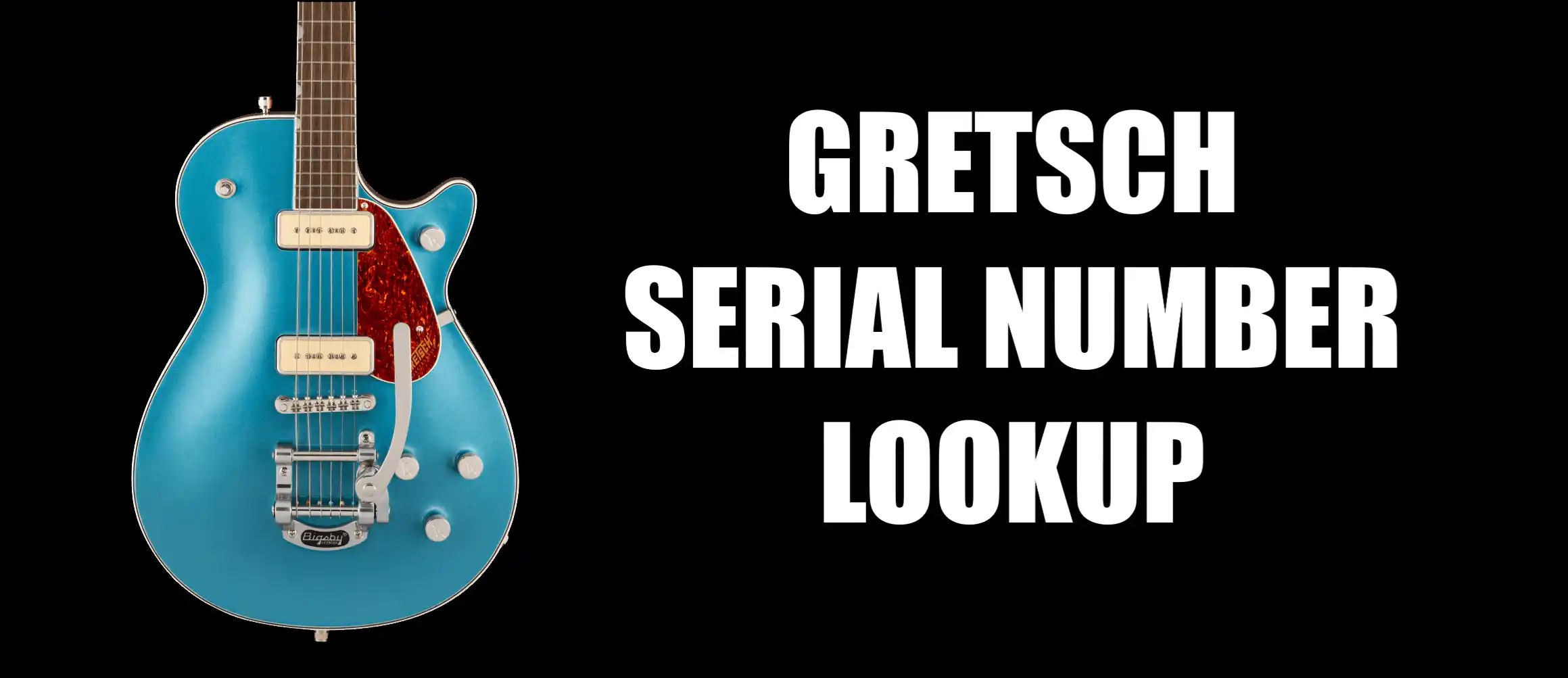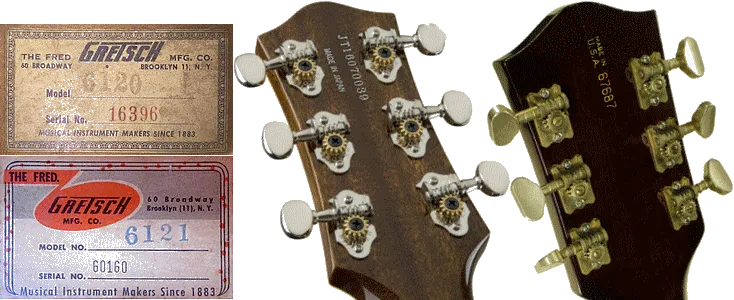
Throughout the years, Gretsch Company has had different owners, each of whom implemented their approach to assigning serial numbers and determining the age of their guitars.
Table of Contents
Gretsch Serial Number Location
The majority of Gretsch guitars produced after 1989 feature the serial number located at the back of the headstock. However, some models produced between 1962 and the late 1960s may have serial numbers on the top of the headstock or the pickguard.
Vintage Gretsch guitars often contain a label that can be seen through the F-hole on a hollow body or in a single control cavity on a solid body.
Before 1949, Gretsch guitars did not have labels, and the serial number was written in pencil inside the instrument.

Vintage Gretsch Serial Number 1939-1954
In the early years (1939-1945) Gretsch started with handwritten sequential serial numbers (001-999), written directly on the inside of the guitar.
Often these serials are vague or almost illegible or completely erased.
If you see at least three hard-to-read numbers, you can be pretty sure that it is a pre-war instrument.
In the period from 1945 to 1954, there was the transition from handwritten serial numbers to the official labels in 1949, although the numbering remained the same.
The following serials are approximate. In general, a higher number means that the guitar was produced later in the year or transferred to the next year’s range.
Serial Number Chart 1939-1954
| SERIAL NUMBER | PRODUCTION YEAR |
|---|---|
| Down 1000 | Pre-World War II |
| 1000 to 20xx | 1945-1947 |
| 20xx to 30xx | 1948-1949 |
| 30xx to 40xx | 1950 |
| 40xx to 50xx | 1951 |
| 50xx to 70xx | 1952 |
| 70xx to 90xx | 1953 |
| 90xx to 130xx | 1954 |
Gretsch Serial Number 1954-1965
From 1954 to 1965 the consecutive numbering scheme remained the same. The only difference is that the number of guitars produced (and therefore serial number) is higher.
serial number Chart 1955-1965
| SERIAL NUMBER | PRODUCTION YEAR |
|---|---|
| 130xx to 180xx | 1955 |
| 180xx to 210xx | 1956 |
| 210xx to 260xx | 1957 (*) |
| 260xx to 300xx | 1958 |
| 300xx to 340xx | 1959 |
| 340xx to 390xx | 1960 |
| 390xx to 450xx | 1961 |
| 451xx to 530xx | 1962 |
| 530xx to 630xx | 1963 |
| 630xx to 770xx | 1964 |
| 770xx to 840xx | 1965 (*) |
(*) In 1957, about a thousand Gretsch serial number labels were lost for unknown reasons. It was not until 1965 that part of this was found and used for that year’s production.
Gretsch Serial Number 1966-1972
With the imminent acquisition by Baldwin and the annual production of approximately 150,000 guitars, Gretsch switched to a date-linked coding system in August 1966.
Strangely enough, some guitars have the serial number stamped into the narrow top of the headstock, while others have it stamped on the back. From June of 1967, the text ‘Made in the USA’ is stamped next to the serial number.
The date-code distribution used from 1966 to 1972 (without a hyphen in the serial number):
The first digit(s) represents the month of manufacture (1-12 for January-December).
The second digit is the last digit of the year (6, 7, 8, 9, 0, 1, 2 for 1966-1972).
The last three digits are the production number of that month.
Example 129800:
Month: December, Year: 1969, Production number: 800.
Gretsch Serial Number 1972-1981
The guitars manufactured from 1972-1981 are easier to identify because they are the only Gretsch specimens with a hyphen (or a space) after the first one or two digits.
The meaning of the numbers is the same as that without a hyphen.
The digits for the hyphen are for the month (1-12).
The first position after the hyphen (or space) represents the last digit of the year (2, 3, 4, 5, 6, 7, 8, 9, 0, 1 for 1972-1981).
The last three digits represent the production number for that month.
Example: 6–2752
Month: June, Year: 1972, Production number: 752.
Gretsch Serial Number Japan 1989-2002
Before the acquisition by Fender, a more logical sequential application for the period 1989-2002 is the production made in Japan with a xxxxxx-xxx serial number.
The first two digits are the year, and the next digit or two digits are the month (1-9/10-12). The subsequent three digits are the model number, e.g., 120 = G6120.
The digits after the hyphen show the production number during the execution of the model (not for that month or year).
Example: 976120-123
Month: June, Year: 1997, Model: 120, Production number: 123
Modern Gretsch Serial Numbers Since 2003
In 2003 Gretsch was acquired by Fender. Fender decided to introduce a single serial number system for all guitars after 2002.
The Gretsch serial number now has a 2-letter prefix indicating the location of the production, followed by a two-digit year a two-digit month, and a four-digit production number related to that specific plant.
Gretsch production location decoder
| Prefix | Country | Factory |
|---|---|---|
| CS | United States | Custom Shop |
| CY | China | Yako |
| GP | Korea | Peerless (until 2002) |
| KP | Korea | Peerless |
| KS | Korea | SPG (Sound Professional Guitar Co, Ltd.) |
| JD | Japan | Dyna Gakki |
| JF | Japan | FujiGen Gakki |
| JT | Japan | Terada |
| IS | Indonesia | Samick |
Example: KS14053456.
Year of manufacture: 2014. Month: May. Manufacture: Korea (factory: SPG). Production number: 3456.
Whenever I see a Gretsch guitar, I’m transported to the era of vintage American design and music. Not being a professional guitarist in that genre, I struggled to bring out its characteristic sound, often ending up playing my heavy metal riffs on a hollow body, which sounded a bit odd. But I’ve seen musicians with “magical” hands draw out its soul, and it was fantastic. Every horse has its rider, but these guitars are undeniably beautiful.